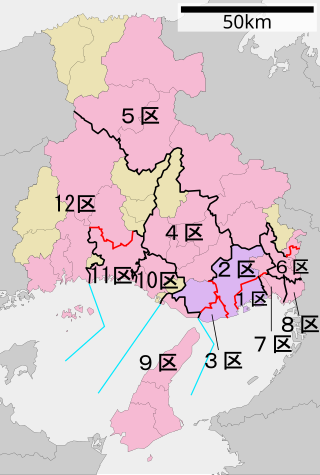
The House of Representatives is the lower house of the National Diet of Japan. The House of Councillors is the upper house. The composition of the House is established by Article 41 and Article 42 of the Constitution of Japan. The House of Representatives has 465 members, elected for a four-year term. Of these, 176 members are elected from 11 multi-member constituencies by a party-list system of proportional representation, and 289 are elected from single-member constituencies.

The House of Councillors is the upper house of the National Diet of Japan. The House of Representatives is the lower house. The House of Councillors is the successor to the pre-war House of Peers. If the two houses disagree on matters of the budget, treaties, or the nomination of the prime minister, the House of Representatives can insist on its decision. In other decisions, the House of Representatives can override a vote of the House of Councillors only by a two-thirds majority of members present.

The Japanese political process has two types of elections.

House of Councillors elections were held in Japan on 29 July 2001. They were the first national elections since Junichiro Koizumi became Prime Minister after Yoshiro Mori resigned in April 2001. The Liberal Democratic Party (LDP) and its election allies, were the major winner, provided Koizumi a strong mandates to move forward with his reform policies. The ruling coalition performed well, and regain their majority in the House of Councillors.

Akihiro Ota is a Japanese politician of the Komeito Party, currently serving his seventh term in the House of Representatives in the National Diet. Ota has represented three districts within the Tokyo metropolis since first entering the national Diet in 1993. He served as president of the Komeito Party from 2006 until the general election in September 2009, at which time he lost his seat in the Diet. Upon his return to the House in December 2012, Ota was appointed as the Minister of Land, Infrastructure, Transport and Tourism, a post he held until October 2015.

The Hokkaido at-large district is a constituency of the House of Councillors in the Diet of Japan. It consists of the prefecture (dō) of Hokkai[dō] and is represented by six Councillors electing three at a time every three years by single non-transferable vote for six-year terms. In the election period from 2019 to 2022, Hokkaido's Councillors are :

Hyogo 11th district is a constituency of the House of Representatives in the Diet of Japan. It is located in Southwestern Hyōgo and is based on the 1995 borders of the city of Himeji; the former towns of Ieshima, Yumesaki, Kōdera and Yasutomi that merged into Himeji in 2006 are part of the 12th district. As of September 2015, 387,509 eligible voters were registered in the district.

The Shikoku proportional representation block is one of eleven proportional representation (PR) "blocks", multi-member constituencies for the House of Representatives in the Diet of Japan. It consists of Shikoku region covering Tokushima, Kagawa, Ehime and Kōchi Prefectures. Following the introduction of proportional voting it elected seven representatives in the 1996 general election. When the total number of PR seats was reduced from 200 to 180, the Shikoku PR block shrank to six seats.

The Tōkyō proportional representation block, or more formally the proportional representation tier "Tokyo Metropolis electoral district", is one of eleven proportional representation (PR) "blocks", multi-member constituencies for the House of Representatives in the Diet of Japan. It consists solely of the prefecture of Tokyo making it one of two blocks covering only one prefecture, the other being Hokkaido. Following the introduction of proportional voting Tokyo elected 19 representatives by PR in the 1996 general election, and 17 since the election of 2000 when the total number of PR seats was reduced from 200 to 180.

Ishikawa 2nd district is a single-member constituency of the House of Representatives, the lower house of the national Diet of Japan. It is located in Southern Ishikawa Prefecture and covers the cities of Komatsu, Kaga, Nomi, Hakusan, Nonoichi and the town of Kawakita.

Yamaguchi 4th district is a single-member electoral district for the House of Representatives, the lower house of the National Diet of Japan. It is located in Western Yamaguchi and consists of the cities of Shimonoseki and Nagato. The seat was held by former Prime Minister of Japan Shinzo Abe until his assassination in July 2022. As of September 2011, 266,456 voters were registered in the district, giving its voters well above average vote weight. Unlike many prefectures where the capital is also the most populous city, Yamaguchi's major city is Shimonoseki, located at the western tip of Honshū and adjacent to Kyushu island's Fukuoka-Kitakyūshū metropolitan area which lies just south across the Kanmon Straits.

House of Councillors elections were held in Japan on Sunday 10 July 2016 to elect 121 of the 242 members of the House of Councillors, the upper house of the National Diet, for a term of six years. As a result of the election, the Liberal Democratic Party–Komeito coalition gained ten seats for a total of 145, the largest coalition achieved since the size of the house was set at 242 seats.

The Hyogo at-large district is a constituency that represents Hyogo Prefecture in the House of Councillors in the Diet of Japan. It currently has five Councillors in the 242-member house, but this representation will increase to six by July 2019.
The Tottori-Shimane at-large district is a constituency of the House of Councillors in the Diet of Japan. It was formed pursuant to a 2015 revision of the Public Officers Election Law from a merger of the Tottori and Shimane at-large districts, the two smallest districts in the country, to address the imbalance in representation between rural and urban voters. The district has 1,068,348 registered voters and was contested for the first time at the House of Councillors election that was held on 10 July 2016.

Kazuhiko Aoki is a Japanese politician. After an earlier career working for a television broadcasting company, he entered the field of politics, serving as secretary to his politician father Mikio Aoki since 1999. In 2010 he succeeded his father as a member in the House of Councillors for the Shimane at-large district. A member of the Liberal Democratic Party, Aoki was re-elected to the House in July 2016 as the member for the merged Tottori-Shimane at-large district. He is affiliated to the revisionist lobby Nippon Kaigi.
The Japanese National Proportional Representation Block, known in Japan as the House of Councillors proportional district is an electoral district for the House of Councillors, the upper house of the National Diet of Japan. It consists of the whole nation and elects 50 members per election, 100 in total, by D'Hondt method proportional representation (PR).

Prefectural elections for the Tokyo Metropolitan Assembly were held on 4 July 2021. The 127 members were elected in forty-two electoral districts, seven returning single members elected by first-past-the-post, and thirty-five returning multiple members under single non-transferable vote. Two districts had their magnitude adjusted in this election to match population changes.

Kagoshima at-large district is a constituency in the House of Councillors of Japan, the upper house of the Diet of Japan. It currently elects two members to the House of Councillors, one per election. It has, historically, similar to other 2-seat, rural prefectures, been an LDP stronghold. The last opposition member elected was before the House of Councilor seat reform, when the JSP successfully elected a candidate in 1995. The closest any party has come to defeating the LDP in the district since was 2007, when Ino Minayoshi lost by only three thousand votes. However, LDP candidates in the district have typically been kept below 50%, mainly due to LDP-infighting; Shuji Maeda took 15% of the vote in the district in 2019, which kept Otsuji below 50%, and in 2022, Ayumi Saigo took a similar amount of the vote, leading to Nomura receiving just under 50% again.

House of Councillors elections were held in Japan on 10 July 2022 to elect 125 of the 248 members of the upper house of the National Diet, for a term of six years. The elections occurred after the assassination of Shinzo Abe, former Prime Minister of Japan on 8 July 2022. The elected candidate with the fewest votes in the Kanagawa prefectural district will serve for three years, as the district combined its regular and byelections.


















